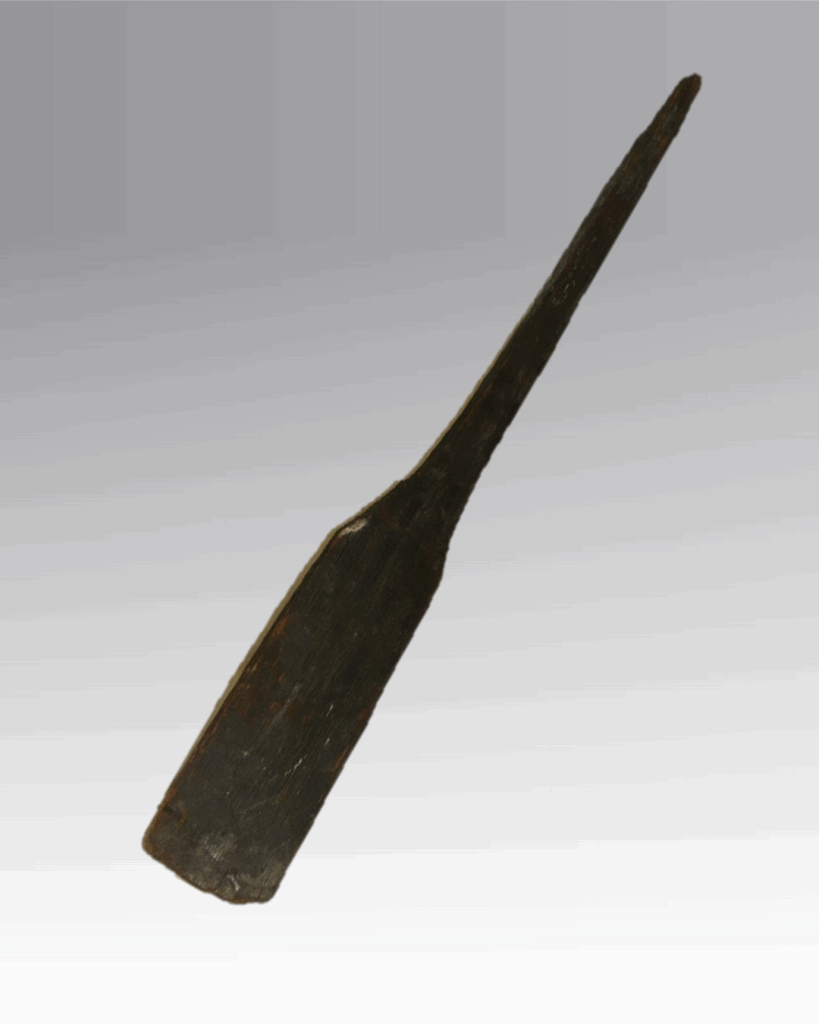
Kāheru (spade)
-
This kāheru (also spelled kaaheru) is a traditional Māori gardening spade, likely used for light agricultural work such as turning soil in preparation for planting kūmara. Kūmara, also known today as sweet potato, was a key staple in the diet of the Māori mana whenua. It was discovered by archaeologists in a swamp near Te Miro, northeast of Cambridge. The wet conditions of the site helped preserve the wooden tool.
A description of such horticultural life was recorded in 1856, when land speculator Josiah Firth visited Ngāti Hauā chief Wiremu Tāmihana at his village on the eastern foothills of Maungakawa:
“It was beautifully situated on a number of gentle eminences; on the summit of every hill were located the Whares (houses) of a Hapu (kindred families), each surrounded by its own little plantations of wheat, maize, kūmaras and potatoes. Every cluster of houses was hidden in its grove of peach trees, and was provided with a Patuka [sic] (storehouse) raised three feet from the ground on strong posts, with projecting timber caps as a precaution against rats…
JC Firth, Nation Making, (London, Longmans Green, 1890) pp. 35-37, cited in Stokes, pp. 84-85. Quoted in J Luiten (2018) Pukemako and Te Tāpui (historic research commissioned by the Waipā District Council) p.36
Early Māori gardening ingenuity explored
Archaeologist Warren Gumbley’s studies of the Waikato Horticultural Complex: Adaptation of Polynesian Agronomy to a Temperate Environment (External link to research)
If you know your paspalum from your potatoes, you’ll understand the challenges of growing crops in Waipā. Archaeologist Warren Gumbley has been unearthing the history of food gardens in early Māori communities for decades.
Warren’s studies focus on kῡmara which travelled to Polynesia from South America about 100 years before the first waka travelled to New Zealand. When Polynesian settlers arrived in New Zealand around the 13th century, they brought with them a wealth of horticultural knowledge suited to tropical climates. However, adapting these practices to the New Zealand climate required significant innovation and adaptation
Kūmara is a tropical crop and requires warm, frost-free growing conditions, not always guaranteed in our cooler climate and especially during the Waikato winter. As Māori settlements moved inland upriver, they had to solve two key challenges: how to create warm, well-drained soils for their kῡmara crop and how to store seed crops over the colder seasons ready for spring planting. Aerial photographs from the 1940s (external link to Retrolens) illustrate the extensive evidence of market gardens that once remained in fields, riversides and backyards. Fortunately, Warren Gumbley has documented much of the evidence before it has been covered by new urban development.
Notable features were the large depressions known as borrow pits. These were remnants of quarries where sand and gravel were extracted to create a gardening mixture called ‘made soil.’ Archaeologists understood that adding these coarse grains improved soil drainage and warmth making them better suited to grow kῡmara. But until bowl-shaped hollows were found in the Waikato in 1998, little was known about how these gardens may have looked.
Adaptation in the Cambridge Area
Gumbley identified several pre-European Māori garden sites with these modified soils to the south of Cambridge and along the banks of the Waikato River above Cambridge. These gardens provided evidence of the sophisticated land management and agricultural practices developed by Māori to sustain their communities.
Impact on our understanding
Gumbley’s work continues to influence contemporary perspectives on Māori culture, emphasising the sophisticated and adaptive nature of their agricultural practices. The insights he shared with us not only celebrated the achievements of early Māori communities but also gave us a deeper recognition of New Zealand’s rich cultural heritage.
To see a good example of the once widespread kūmara plantings, visit Te Parapara Garden at the Hamilton Gardens.
- Accession No: CM467
- Where made: Aotearoa/New Zealand
- Materials: Wood
- Measurements: 123 x 19.5 x 4.5cm
